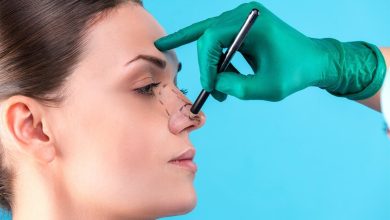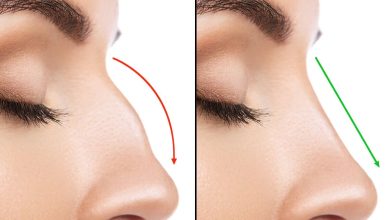Septum Deviation (Crooked Nose — Nasal Septum Deviation)
What Is Septum Deviation?
The anatomical structure that divides the two airway tunnels in the middle of the nose and has a thin bone in the back and cartilage in the front is shortly called the “septum”. Due to a variety of factors, this structure may be skewed to the right or left of the midline, or both, resulting in a deformity known as septum deviation (crooked nose).
Why Is A Septum Deviation Important?
Septum deviation (crooked nose) prevents nasal breathing through one or both nostrils, and as a result, limits physical performance, impairs upper respiratory tract health, and lowers the quality of sleep and life. Impaired dynamics of nasal breathing may lead to dryness of the nasal mucosa and associated nosebleeds, as well as recurrent attacks of sinusitis by blocking the openings of the sinus ducts into the nose.
On the other hand, septum deviation may also distort the external appearance of the nose, causing aesthetic problems in addition to health problems.
What are the Causes of Septum Deviation?
In most cases, the cause of the septum deviation cannot be identified. It can be a congenital deformation of the facial bones, or it can develop as a result of trauma to the nose during normal birth. Septum deviation is mostly caused by traumas to the nasal area;
- In infancy and childhood,
- While doing sports,
- While playing on the playground,
- During traffic accidents In most cases, patients do not remember a specific history of trauma.
What are the Signs of Septum Deviation?
- When any of the following signs are observed, a septum deviation problem should be suspected:
- Difficulty in nasal breathing through one or both nostrils,
- Frequent nose bleeding,
- Frequent attacks of sinusitis,
- Headache,
- post-nasal drainage,
- Sleeping with the mouth open at night and associated dryness in the mouth and throat,
- Noisy nasal breathing during sleep in infants and children,
- The need to constantly lie on one side because it is easier to breathe through the nose.
Under normal circumstances, people with mild septum deviation do not exhibit obvious respiratory distress; however, even a minor cold or upper respiratory tract infection causes swelling in the nasal mucosa, and breathing difficulties start immediately. When the infection resolves, the respiratory problem resolves as well.
On the other hand, it is not possible to breathe equally comfortably through both nostrils at the same time in normal noses without septum deviation as well. For a while, it is simpler to breathe through one of the nostril, but after a while, it is simpler to breathe through the other one. This alters successively throughout the day and it is completely physiological, so should not to be confused with septum deviation.
In addition, respiratory problems encountered after swelling of the nasal mucosa due to allergic causes should not be confused with deviation. Both deviation and allergy can coexist in some cases. In such cases, both causes should be treated separately.
How Is A Septum Deviation Diagnosed?
A septum deviation is diagnosed by examining the inside of the nose with the naked eye and with the help of fiberoptic camera systems. Computed tomography, also known as Paranasal Sinus Tomography, is an extremely useful diagnostic technique used to reveal both the intranasal structures and the condition of the sinuses around the nose. Pathological conditions that cannot be identified with the naked eye are thus more easily identified, and the operation plan is made more accurately.
Should Every Septum Deviation Be Surgically Corrected?
It is not necessary to surgically correct mild septum deviations that do not impair the quality of daily life or cause health problems. However, surgery should be considered if the aforementioned complaints persist despite medical treatment.
What Is The Lower Age Limit For Surgical Correction Of Septum Deviation?
The mid-face and nasal bones continue to grow and develop until 16 to 18 years of age for women and 18 to 20 years of age for men. Surgery is not recommended before these ages unless absolutely necessary, because surgical interventions performed on the nose’s growth centers before these ages are likely to negatively affect the nose’s growth and development.
On the other hand, some conditions require immediate intervention to the nose. These include cancers, abscesses or blood accumulation (hematoma) in the septum, severe nasal trauma (traffic accident, falling from a height, etc.), cleft lip deformity, or worsening nasal deformity.
How Is Septoplasty (Deviated Septum Surgery) Performed?
Septoplasty, also known as deviated septum surgery, should be performed in a full-fledged operating room. Before the surgery, foods with blood thinning effect should be discontinued and necessary blood tests should be performed. Depending on the degree of septum deviation and the extent of the surgical procedure, the operation is performed under intravenous sedation and local anesthesia or under general anesthesia.
To correct the existing deviation, some of the cartilages with curvature are removed, and the cartilages that serve as a support for the nose are corrected and brought to the midline. Deviation surgery is not a standard procedure; it can be a very limited intervention depending on the existing anatomical deformity, or it can be a comprehensive surgical procedure that involves the correction of all nasal cartilage and bone structures.
In the preoperative interviews, the surgeon who will perform the operation determines the degree of the deviation, makes the treatment plan, and informs the patient. In some cases, in addition to correcting the deviation, some other procedures are performed on the sinuses, such as reducing the enlarged nasal concha (concha hypertrophy) and widening the openings of the sinus ducts into the nose.
Should Septoplasty Be Performed In Conjunction With Rhinoplasty?
If, in addition to correction the deviation, there is a need or request for changing the external appearance of the nose, it is best to perform both septoplasty (deviated septum surgery) and rhinoplasty procedures in the same session. This is because the cartilage tissues removed during the septoplasty operation are the most important natural supporting structures used to reshape the nose.
Rhinoplasty may be more difficult in people who have previously had a septoplasty operation because the cartilage to be used as supporting structures may have been disposed of. To provide support, cartilage from other parts of the body, such as the ear and ribs, or synthetic materials may be required.
Recovery Period after Septoplasty (Deviated Septum Surgery)
Depending on the anesthesia used during septoplasty and the extent of the surgical procedure, the patient may be able to return home the same day or spend the night in the hospital. It is of great importance to lie in a semi-sitting position after surgery, in order to reduce blood leakage from the nose.
For the same reason, it is necessary to avoid movements that would otherwise increase the pressure in the nose, such as excessive straining, bending forward, carrying heavy objects, talking a lot, and walking. It is very important to stay calm, avoid getting excited, apply cold, and consume adequate amount of liquids and food during the postoperative period.
In most cases, patients gradually return to their daily lives within the first week after surgery. Depending on the additional procedures performed, the recovery from swelling, scab formation etc. in the nose caused by surgery may take 6 weeks on average.
References




